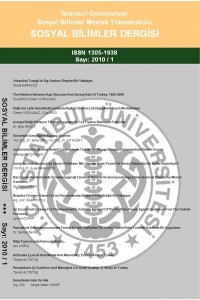Abstract
Determination of saving behavior can be sought as a main issue for economies and can be handled with an extensive perspective regarding the relation between other macro economic policy variables. In this paper, saving rate in Turkey with age structure dimension is examined. As economic theory supports, age explains savings rate. Within the context probable long run relation between them is based on Modigliani’s Life-cycle Model and in trying to shed light on the relation, cointegration tests were performed. The test results verify the relation and the empirical findings hold with life-cycle hypothesis of savings. That means, in Turkey, while stating any regulation to affect saving level, age structure influences are needed to be regarded.
References
- Baltagi, B. (2003), A companion to Theoritical Econometrics, Blackwel Publishing, Germany.
- Cromwell, J. Hannan M. Labys and W. Terraza M. (1994), Multivariate Tests for Time Series Models, Sage University Paper.
- Edwards, S. (1994) "Why Are Saving Rates so Different Across Countries? An International Comparative Perspective", NBER Working Paper No. 5097.
- Enders, W. (1995), Applied Econometric Time Series, John Wiley and Sons: New York.
- Engle, R. and Granger C.W., (1987), “Co-integration and error correction: representation, estimation and testing”, Econometrica, 49, 661-692.
- Ersel, H. (2006), “Tasarruf Eğilimindeki Değişme”, Referans Gazetesi, Arşiv, 12.10.2006.
- Guest, R.S. and Mcdonald, I.M. (2004), “Demographic Transition and Optimal Saving In Four Asian Countries”, Economic Analysis & Policy, Vol. 34, No. 1, 1-13.
- Gupta, K. L. (1971) “Dependency Rates and Savings Rates: Comment”, American Economic Review, Vol. 61, 469-71.
- Işık, O. (2001), “2020 Yılında Nasıl Bir Demografik Tablo”, www.ttb.org.tr
- Kelley, A. and Williamson, J. (1968), “Household Saving Behavior in the Developing Economies: The Indonesian Case”, Economic Development and Cultural Change, Vol. 16, No. 3, 385-403.
- MacKinnon, J. (1990), “Critical Values for Cointegration Tests”, Discussion Paper, University of California San Diego.
- Modigliani, F. (1970), The life-cycle hypothesis of saving and intercountry differences in the saving ratio. In Induction, growth and trade: Essays in honour of Sir Roy Harrod. Edited by Walter A. Eltis, Maurice G. Scott, and James N. Wolfe. London: Clarendon / Oxford University Press, 197-225.
- Özcan, K.M., Günay, A. and Ertaç, S. (2003), “Determinants of Private Savings Behaviour in Turkey”, Applied Economics, 35, 1405-1416.
- Tansel, A. (1992), “Household Saving, Income and Demographic Interactions”, Middle East Technical University Studies in Development, 19, 91-114.
- Thornton, J. (2001), “Age Structure and the Personal Savings Rate in the United States, 1956-1995”, Southern Economic Journal, 68, 166-170.
- Toros, A. (2003), “Demografiden Yeni Mesajlar”, Capital Aylık İş ve Ekonomi Dergisi, Kasım sayısı.
- Zivot, E. and Wang J. (2003), Modeling Financial Time Series, Springer Verlag, New York.
- SPO, State Planning Organization
- TSI, Turkish Statistical Institute
- World Development Indicators
Abstract
Ekonomiler için tasarruf davranışının belirlenmesi haklı olarak temel bir sorun olarak görülebilmekte ve diğer makro iktisadi politika değişkenleri ile ilişkisi bağlamında geniş bir perspektifte ele alınabilmektedir. Bu çalışma Türkiye’deki tasarruf oranını yaş yapısı boyutuyla incelemektedir. İktisat teorisinin de desteklediği gibi yaş, tasarruf oranını açıklar. Bu bağlamda değişkenler arasındaki olası ilişki Lifecycle Modeline dayandırılmıştır ve bu ilişki kointegrasyon testleri ile açıklanmaya çalışılmıştır. Test sonuçları ilişkiyi doğrulamaktadır ve deneysel bulgular da tasarruf hipotezine uymaktadır. Turkiye’de düzenlemeler yapılırken tasarruf seviyesine etki etmek için yaş yapısının etkisinin gözönüne alınması gerekmektedir.
References
- Baltagi, B. (2003), A companion to Theoritical Econometrics, Blackwel Publishing, Germany.
- Cromwell, J. Hannan M. Labys and W. Terraza M. (1994), Multivariate Tests for Time Series Models, Sage University Paper.
- Edwards, S. (1994) "Why Are Saving Rates so Different Across Countries? An International Comparative Perspective", NBER Working Paper No. 5097.
- Enders, W. (1995), Applied Econometric Time Series, John Wiley and Sons: New York.
- Engle, R. and Granger C.W., (1987), “Co-integration and error correction: representation, estimation and testing”, Econometrica, 49, 661-692.
- Ersel, H. (2006), “Tasarruf Eğilimindeki Değişme”, Referans Gazetesi, Arşiv, 12.10.2006.
- Guest, R.S. and Mcdonald, I.M. (2004), “Demographic Transition and Optimal Saving In Four Asian Countries”, Economic Analysis & Policy, Vol. 34, No. 1, 1-13.
- Gupta, K. L. (1971) “Dependency Rates and Savings Rates: Comment”, American Economic Review, Vol. 61, 469-71.
- Işık, O. (2001), “2020 Yılında Nasıl Bir Demografik Tablo”, www.ttb.org.tr
- Kelley, A. and Williamson, J. (1968), “Household Saving Behavior in the Developing Economies: The Indonesian Case”, Economic Development and Cultural Change, Vol. 16, No. 3, 385-403.
- MacKinnon, J. (1990), “Critical Values for Cointegration Tests”, Discussion Paper, University of California San Diego.
- Modigliani, F. (1970), The life-cycle hypothesis of saving and intercountry differences in the saving ratio. In Induction, growth and trade: Essays in honour of Sir Roy Harrod. Edited by Walter A. Eltis, Maurice G. Scott, and James N. Wolfe. London: Clarendon / Oxford University Press, 197-225.
- Özcan, K.M., Günay, A. and Ertaç, S. (2003), “Determinants of Private Savings Behaviour in Turkey”, Applied Economics, 35, 1405-1416.
- Tansel, A. (1992), “Household Saving, Income and Demographic Interactions”, Middle East Technical University Studies in Development, 19, 91-114.
- Thornton, J. (2001), “Age Structure and the Personal Savings Rate in the United States, 1956-1995”, Southern Economic Journal, 68, 166-170.
- Toros, A. (2003), “Demografiden Yeni Mesajlar”, Capital Aylık İş ve Ekonomi Dergisi, Kasım sayısı.
- Zivot, E. and Wang J. (2003), Modeling Financial Time Series, Springer Verlag, New York.
- SPO, State Planning Organization
- TSI, Turkish Statistical Institute
- World Development Indicators
Details
| Primary Language | English |
|---|---|
| Journal Section | Makaleler |
| Authors | |
| Publication Date | January 20, 2012 |
| Published in Issue | Year 2010 Issue: 1 |

